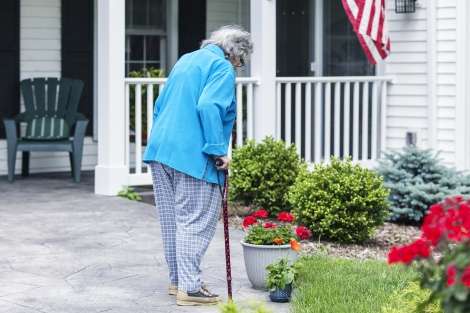For the elderly, physical therapy can help straighten a hunched back

A hunched back affects four out of 10 people over age 65. This extreme forward curvature of the upper back, called hyperkyphosis, increases disability and the risk of falls and fractures, but it's rarely deemed a treatable condition among older people.
A new study by UC San Francisco researchers shows that targeted physical therapy can help straighten the spine and boost a patient's self-esteem.
"Currently, there are some medical providers who say there's nothing you can do about it – there's no treatment," said Wendy Katzman, PT, adjunct professor of physical therapy and lead author of the study published July 8, 2017, in Osteoporosis International. "This is a novel treatment approach for older people who have this condition. There's really been no standard of care to treat this until now."
Historically, hyperkyphosis, which usually progresses with age and is more common in women, has not been seen as a discrete health concern. And although osteoporosis – a condition often associated with hyperkyphosis – is often treated with medication, no medications have been shown to improve hyperkyphosis. Surgery can reduce spinal curvature, but is only considered in extreme cases.
Improving Posture and Well-Being
The study enrolled 99 hyperkyphosis patients over 60 years old to explore if physical therapy is a viable solution for improving hyperkyphosis They had an average upper back curvature, as measured by X-ray, of 57 degrees – well above the average curve of 40 degrees, which is the cutoff for defining hyperkyphosis. The participants were randomly assigned to one of two groups.
One group performed exercises known to target muscle weakness, decreased spinal movement and poor postural alignment with a licensed physical therapist and assistant for one hour, three days a week, for six months. They were also advised to practice ideal posture independently at least three times a day. Katzman and her team compared these patients with those in the second group, which were invited to attend four health education meetings over a period of six months but did not receive physical therapy.
The researchers found that posture improved by an average angle of more than 3 degrees in the group that received physical therapy, and that improvement was greater in those over age 75. There was no significant change in the group invited to the health seminars.
The researchers had hypothesized that the exercises might work by strengthening the back muscles, but they found no significant improvement in patients' spinal muscle strength or quality, or their physical function – illustrated by a test in which they performed a 50-foot floor walk, put on and took off a lab coat and picked a penny up off the floor, among other tasks.
However, the patients that received physical therapy did report better self-image.
"I think it's important for people to feel confident. It's a component of self-efficacy," Katzman said. "What we see is that people who have more self-efficacy are more compliant with physical therapy, so there's potential that self-esteem carries over to other health benefits."
Physical Therapy Meets Technology
Katzman and her team point out that the participants in this proof-of-concept study were relatively healthy and robust: Their walking speed and physical ability was better than average for their age group. This might have limited any improvements to the participants' overall physical function.
Moving forward, the team hopes to recruit people with hyperkyphosis that are less robust and include exercises in the regimen that improve physical function overall. They also plan to push patients harder and enhance postural training with technology.
But even a small improvement can be important, Katzman said. "If you step back and say there was a 3-degree improvement, that doesn't sound like a huge number. However, the progression of hyperkyphosis is very slow. It takes about five years for it to progress 3 degrees."
















